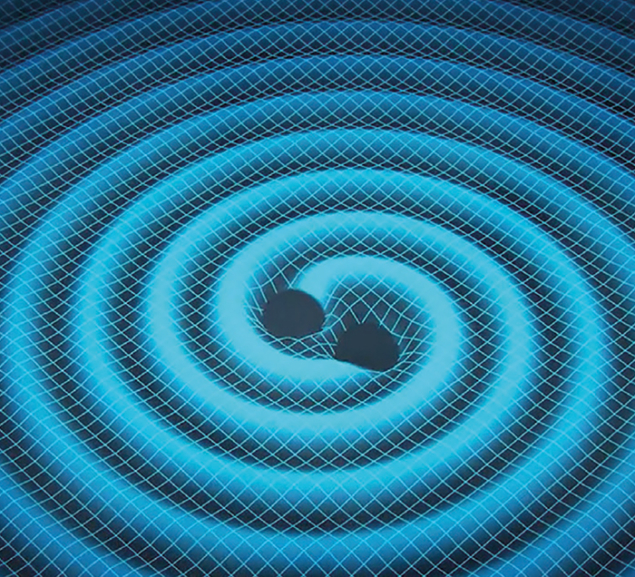
Image credit: Swinburne Astronomy Productions.
A pair of supermassive black holes (SMBHs) in close orbit around each other are expected to produce gravitational waves. The background “rumble” of gravitational waves resulting from many such systems in the universe should be detectable via precise timing of radio pulsars. But an 11 year search has now failed to detect the predicted signal, suggesting the need to revise current models of black-hole binaries in merging galaxies.
There is observational evidence of the presence of a SMBH – a black hole with a mass of at least one-million solar masses – in almost every spiral galaxy. Therefore, when two galaxies merge, their black holes are thought to be drawn together and to form an orbiting pair (CERN Courier November 2015 p17). The separation of the two black holes would then decrease with time, first via interaction with nearby stars and gas, and finally via the emission of gravitational waves.
According to the general theory of relativity, gravitational waves are space–time distortions moving with the speed of light. Precisely 100 years after Einstein’s publication, they have not yet been directly detected. Millisecond pulsars offer an indirect way to detect them. Such neutron stars rotate on themselves hundreds of times per second, and produce extremely regular trains of radio pulses (CERN Courier November 2013 p11). A gravitational wave passing between the Earth and a millisecond pulsar squeezes and stretches space, changing the distance between them by about 10 m. This changes, very slightly, the time when the pulsar’s signals arrive on Earth on a timescale of ~ 0.1 to 30 years. The method requires precision in the pulse arrival time of the order of 10 ns.
Using the 64 m Parkes radio telescope in Australia, scientists monitored 24 millisecond pulsars during 11 years. They focused on four of them having the highest timing precision, but could not find any sign of gravitational waves. The study, published in Science, was led by Ryan Shannon from the Commonwealth Science and Industrial Research Organization and the International Centre for Radio Astronomy Research, Australia. It aimed at detecting the stochastic background of gravitational waves resulting from merging galaxies throughout the universe.
The obtained upper limit on the amplitude of the gravitational wave background is below the expectations of current models. A possible explanation of the discrepancy is linked to the environment of the black-hole pairs at the centre of merging galaxies. In the presence of more surrounding gas, the black holes would lose more rotational energy via friction. Their orbit would shrink quicker, therefore shortening the time when gravitational waves are emitted. Another possibility is that the galaxy merger rate is lower than expected.
Whatever the explanation, it means that the detection of gravitational waves by timing pulsars will require more intense monitoring. This has, however, no implications for ground-based gravitational-wave detectors such as Advanced LIGO (the Laser Interferometer Gravitational-Wave Observatory), which look for higher-frequency signals generated by other sources, such as coalescing neutron stars.







